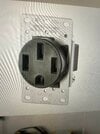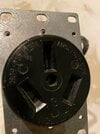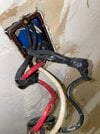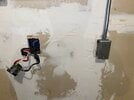Hi All, Getting a 2021 Model Y tomorrow and my garage(new house) has a NEMA 10-50 outlet. I am trying to change the outlet to 14-50.
Info:
1. The wiring is 6AWG from circuit breaker(50) to the outlet and then to a hot tub(Circuit breaker is shared) (see the picture added )
2. The box is a plastic box and I dont see any ground wire coming in to the box.
3. there is an unused 110/120 box right by the side of the NEMA 10-50 and this does have ground wire.
Questions:
1. Is it okay to have the shared circuit breaker in this case ?
2. Do I need to have a ground wire for replacing this NEMA 10-50 to 14-50. (if no, then will there be any risk ) ?
3. Can I get the ground wire connection the unused box and use it !
Please enlighten me! thanks
Info:
1. The wiring is 6AWG from circuit breaker(50) to the outlet and then to a hot tub(Circuit breaker is shared) (see the picture added )
2. The box is a plastic box and I dont see any ground wire coming in to the box.
3. there is an unused 110/120 box right by the side of the NEMA 10-50 and this does have ground wire.
Questions:
1. Is it okay to have the shared circuit breaker in this case ?
2. Do I need to have a ground wire for replacing this NEMA 10-50 to 14-50. (if no, then will there be any risk ) ?
3. Can I get the ground wire connection the unused box and use it !
Please enlighten me! thanks






